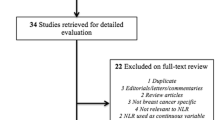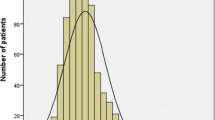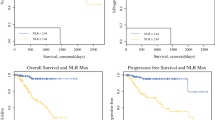Abstract
Purpose
Elevated markers of host inflammation, a hallmark of cancer, have been associated with worse outcomes in several solid tumors. Here, we explore the prognostic role of the derived neutrophil-to-lymphocyte ratio (dNLR), across different tumor subtypes, in patients with early breast cancer.
Patients and methods
This was a retrospective analysis of 1246 patients with lymph node-positive, operable early breast cancer enrolled in the GEICAM/9906 trial, a multicenter randomized phase 3 study evaluating adjuvant chemotherapy. dNLR was calculated as the ratio of neutrophils and the difference between total leukocytes and neutrophils in peripheral blood before chemotherapy. Disease-free survival (DFS) and overall survival were explored using a Cox proportional hazard analysis.
Results
The analysis comprised 1243 (99.8%) patients with dNLR data, with a median follow-up of 10 years. Data on intrinsic subtypes were available from 818 (66%) patients (luminal A 34%, luminal B 32%, HER2-enriched 21% and basal-like 9%). Median dNLR was 1.35 [interquartile range (IQR) 1.08–1.71]. In the whole population, dNLR was not prognostic after adjustment for clinico-pathological factors. However, dNLR ≥ 1.35 was independently associated with worse DFS in the hormone receptor-negative/HER2+ population (HR 2.86; p = 0.038) and in patients with one to three lymph node metastases (HR 1.32, p = 0.032). There was a non-significant association with worse DFS in non-luminal and in HER2-enriched tumors (HR 1.40, p = 0.085 and HR 1.53, p = 0.067). No significant interaction was observed between the treatment arm and dNLR.
Conclusion
Elevated dNLR appears to be an adverse prognostic factor in hormone receptor-negative early breast cancer.
Trial registration
EudraCT: 2005-003108-12 (retrospectively registered 28/06/2005). ClinicalTrials.gov Identifier: NCT00129922 (retrospectively registered 10/08/2005). Results of this study were presented in part at the 2016 ESMO conference October 7–11, 2016, Copenhagen, Denmark (oral presentation).




Similar content being viewed by others
References
Hanahan D, Weinberg RA. Hallmarks of cancer: the next generation. Cell. 2011;144:646–74.
Proctor MJ, McMillan DC, Morrison DS, et al. A derived neutrophil to lymphocyte ratio predicts survival in patients with cancer. Br J Cancer. 2012;107:695–9.
Ethier JL, Desautels D, Templeton A, et al. Prognostic role of neutrophil-to-lymphocyte ratio in breast cancer: a systematic review and meta-analysis. Breast Cancer Res. 2017;19:2.
Templeton AJ, McNamara MG, Šeruga B, et al. Prognostic role of neutrophil-to-lymphocyte ratio in solid tumors: a systematic review and meta-analysis. J Natl Cancer Inst. 2014;106(6):dju124. https://doi.org/10.1093/jnci/dju124.
Ocana A, Pandiella A. Targeting oncogenic vulnerabilities in triple negative breast cancer: biological bases and ongoing clinical studies. Oncotarget. 2017;8:22218–34.
Parker JS, Mullins M, Cheang MC, et al. Supervised risk predictor of breast cancer based on intrinsic subtypes. J Clin Oncol. 2009;27:1160–7.
Martin M, Rodriguez-Lescure A, Ruiz A, et al. Randomized phase 3 trial of fluorouracil, epirubicin, and cyclophosphamide alone or followed by paclitaxel for early breast cancer. J Natl Cancer Inst. 2008;100:805–14.
Martin M, Prat A, Rodriguez-Lescure A, et al. PAM50 proliferation score as a predictor of weekly paclitaxel benefit in breast cancer. Breast Cancer Res Treat. 2013;138:457–66.
Martin M, Brase JC, Ruiz A, et al. Prognostic ability of EndoPredict compared to research-based versions of the PAM50 risk of recurrence (ROR) scores in node-positive, estrogen receptor-positive, and HER2-negative breast cancer. A GEICAM/9906 sub-study. Breast Cancer Res Treat. 2016;156:81–9.
Koh CH, Bhoo-Pathy N, Ng KL, et al. Utility of pre-treatment neutrophil–lymphocyte ratio and platelet–lymphocyte ratio as prognostic factors in breast cancer. Br J Cancer. 2015;113:150–8.
Jia W, Wu J, Jia H, et al. The peripheral blood neutrophil-to-lymphocyte ratio is superior to the lymphocyte-to-monocyte ratio for predicting the long-term survival of triple-negative breast cancer patients. PLoS One. 2015;10:e0143061.
Taylor C, Hershman D, Shah N, et al. Augmented HER-2 specific immunity during treatment with trastuzumab and chemotherapy. Clin Cancer Res. 2007;13:5133–43.
De Larco JE, Wuertz BR, Furcht LT. The potential role of neutrophils in promoting the metastatic phenotype of tumors releasing interleukin-8. Clin Cancer Res. 2004;10:4895–900.
el-Hag A, Clark RA. Immunosuppression by activated human neutrophils. Dependence on the myeloperoxidase system. J Immunol. 1987;139:2406–13.
Ocana A, Nieto-Jimenez C, Pandiella A, Templeton AJ. Neutrophils in cancer: prognostic role and therapeutic strategies. Mol Cancer. 2017;16:137.
Loi S, Sirtaine N, Piette F, et al. Prognostic and predictive value of tumor-infiltrating lymphocytes in a phase III randomized adjuvant breast cancer trial in node-positive breast cancer comparing the addition of docetaxel to doxorubicin with doxorubicin-based chemotherapy: BIG 02-98. J Clin Oncol. 2013;31:860–7.
Acknowledgements
The authors thank all investigators, trial coordinators, and the GEICAM staff for their hard work and all patients and their families for participation in the GEICAM/9906 study.
Funding
No specific funding was obtained for this study.
Author information
Authors and Affiliations
Consortia
Corresponding author
Ethics declarations
Ethical approval
The GEICAM 9906 study was approved by the ethics committee and has therefore been performed in accordance with the ethical standards laid down in the 1964 Declaration of Helsinki and its later amendments.
Informed consent
Informed consent was obtained from all individual participants included in the study.
Conflict of interest
The authors declare that they have no conflict of interest.
Electronic supplementary material
Below is the link to the electronic supplementary material.
Rights and permissions
About this article
Cite this article
Templeton, A.J., Rodríguez-Lescure, Á., Ruíz, A. et al. Prognostic role for the derived neutrophil-to-lymphocyte ratio in early breast cancer: a GEICAM/9906 substudy. Clin Transl Oncol 20, 1548–1556 (2018). https://doi.org/10.1007/s12094-018-1885-5
Received:
Accepted:
Published:
Issue Date:
DOI: https://doi.org/10.1007/s12094-018-1885-5




